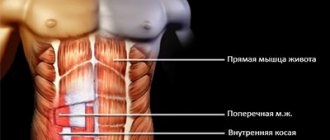“Vacuum in the stomach” is a very effective exercise that came to us from yoga. Using his technique, you will strengthen the internal, transverse abdominal muscles and make it flat. And you will do it quite quickly and effectively, within three weeks. By pumping only your abs, you will not achieve such a result. There are many reasons for the weakening of the transverse abdominal muscle in modern society, ranging from sedentary work with poor nutrition to its atrophy due to lack of physical activity.
It is best to perform the “vacuum in the stomach” exercise in the morning and pump the abs in the evening. By performing the “vacuum” exercise, your belly will no longer stick out like that, it will fall back into its “place” (this is especially true for men, namely their “beer bellies”). Over time, you will get used to the constant tension in the abdominal area, so you will stop paying attention to it. In this article you will find a video with the correct technique, as well as a more detailed description.
Anatomy of the abdominal muscles
The abdominal press consists of external and internal muscle groups:
- External abdominal muscles: Rectus.
- External oblique.
- Internal oblique.
The deepest layer is formed by the transverse abdominal muscles, which encircle the waist and act as a natural corset.
That is, it is this muscle group that is responsible for supporting the internal organs and a flat stomach. The absence of loads on the transverse muscle group contributes to:
- The appearance of excess weight at the waist, since the fibers of these muscles are of the slow type, using subcutaneous fat as an energy source.
- Lack of strength in the muscle corset, which leads to the internal organs squeezing the abdomen forward.
Classic exercises for training the abs (lifting the body, legs, twisting, etc.) mainly work only the external muscle groups that form the relief.
To effectively strengthen the transverse muscles, it is necessary to do static (isometric) exercises. Along with the plank, the best example of a static exercise for developing the internal abdominal muscles is the vacuum .
Does a vacuum help remove belly fat?
The phrase “remove belly fat” can be understood in different ways. Some people put into this concept the complete burning of fat, while others mean tightening muscles, due to which the sagging stomach returns, as it were, “to its place.” It is in the latter case that the vacuum is effective, that is, the exercise affects the deep abdominal muscles, and specifically the transverse muscles, which are responsible for bringing the abdominal muscles closer to the internal organs, ensuring their protection.
Thus, the vacuum strengthens the deep layers of the abs, due to this the effect of a “retracted abdomen” is created.
It is worth understanding that the main effect of the exercise is to tone and return the muscles to their correct physiological state, and not in burning excess fat, although in combination with other techniques this can be achieved, but not with vacuum alone.
How is it useful?
Systematic implementation of abdominal vacuum allows:
- get rid of a stretched and bulging belly;
- significantly reduce your waist size;
- strengthen the abdominal muscles;
- visually enlarge the chest;
- improve posture;
- stabilize the spine and reduce pain in the lower back;
- improve digestion and blood supply to the abdominal organs;
- strengthen the diaphragm muscles;
- reduce the visceral layer of fat that accumulates near the internal organs.
In addition, vacuum gymnastics classes do not require special equipment and are suitable for performing at home and in the office.
Review Reviews
Thousands of women and men have already tried abdominal retraction; reviews indicate its undoubted benefits. People note an improvement in overall body tone, as well as a tighter stomach and waist. The first results can be observed within a week.
Beginners note the complexity of this exercise and say that at first 15 seconds are out of the question, it’s hard to sustain at least a couple of seconds, but after 5-7 days of regular practice, a habit is formed. It is recommended to perform a vacuum for weight loss along with cardio exercises and proper nutrition. This combination helps to lose excess weight and strengthen muscle mass.
Fitness trainers believe that vacuum does not promote weight loss. But it will improve the functioning of organs due to their massage and saturation with oxygen, improve health and teach you to control the body.
How is it done?
In order to do a stomach vacuum correctly, you need to understand its technique. Although at first glance it seems simple, this technique consists of many nuances, mainly related to the intricacies of proper breathing, and includes the following steps.
Namely:
- Position yourself in the starting position.
- Take a deep breath through your nose, trying to direct the air not so much into your lungs as down your stomach. The press should move forward.
- Exhale sharply through your mouth, trying to release all the air out. To do this, you can use the sound “Pha!”
- Hold your breath.
- As you exhale, pull your stomach in as much as possible towards the spine and up, under the ribs.
- Stay in the position as much as possible. To begin with, the duration of the isometric contraction can be 10-15 seconds.
- Gradually relaxing your abs, inhale slowly.
- In the starting position, inhale and exhale 2-3 times, then repeat the exercise the required number of times.
It is necessary to make a vacuum on an empty stomach or 3-4 hours after eating.
Depending on the initial position, the abdominal vacuum is divided into four types:
- lying down;
- on the knees;
- sitting;
- standing.
The technical component of the exercise in each position remains unchanged. The only difference is the complexity of its implementation.
Vacuum lying down
The supine vacuum is considered one of the easiest to perform and is suitable for any beginner. In this position, gravity itself helps to retract the abdominal muscles.
How to do:
- Sit on a flat surface.
- Straighten your arms along your body.
- Bend your knees or stretch your legs forward.
- Apply the vacuum using proper technique.
Vacuum on your knees
As soon as you have mastered the technique of the “vacuum” exercise and can easily do 3-5 approaches of 1-2 minutes in a lying position, you can begin to vacuum on your knees (“on all fours”).
This option is considered somewhat complicated, because in this case you need to create a vacuum against gravity.
How to do:
- Sit on your knees.
- Place your palms on the floor at shoulder level.
- Do not bend your elbows and make sure your back is straight: do not slouch or arch your lower back.
- Apply the vacuum using proper technique.
Vacuum sitting
Sitting vacuum is another complicated option that uses the stabilizer muscles responsible for maintaining the balanced position of the spine.
How to do:
- Sit on a chair or any flat surface.
- Place your hands on your knees.
- Do not lean against the back of the chair.
- Control the position of your back: it should remain straight.
- Apply the vacuum using proper technique.
If desired, you can complicate the task and increase the load in this position. To do this, you need to sit not on a chair, but on a surface that provides unstable support, for example, a fitball.
You can also do a vacuum in the abdomen while sitting on your knees (not to be confused with a vacuum “on all fours”, where the body is parallel to the floor):
- Get on your knees.
- Take a sitting position.
- Move your hips away from your heels by 20-25 cm.
- Make sure that the body is perpendicular to the floor.
- Apply the vacuum using proper technique.
Vacuum standing
As you progress, move on to the most difficult type - standing vacuum. This option will allow you to maximize the use of the internal abdominal muscles and back stabilizer muscles.
How to do:
- Stand straight with your feet shoulder-width apart and knees slightly bent.
- Straighten your arms along your body.
- Make sure your back remains straight and your shoulders down.
- Apply the vacuum using proper technique.
There are several more variations of performing a vacuum from a standing position:
- Simplified standing vacuum. The hands are placed on the knees, the body moves forward, resulting in additional support.
- Complicated standing vacuum. The hands are placed behind the head, which allows the upper abdominal muscles to be even more involved in the work.
Common Beginner Mistakes
Immediately make sure that you do the abdominal vacuum correctly; as a rule, beginners make the same mistakes. Learn from others' experiences and you won't have to commit them.
- Too short a rest period between sets. Take a breath and relax your muscles before tensing them again.
- Workout on a full stomach. You will not be able to draw your stomach in as much as possible if there is food in it. Additionally, it may affect digestion.
- Give up classes after feeling slightly dizzy. This is a normal reaction of the body to exercise. If nothing else bothers you, continue to exercise, and after a few days the symptom will disappear.
- Improper breathing, which causes pain in the abdominal area.
Listen to your feelings. If you feel bad or have pain, you need to stop exercising and consult a doctor. Maybe you are doing the exercise incorrectly, or you have contraindications.
Efficiency
- The effectiveness of a vacuum for the abdomen directly depends on the regularity and intensity of training. Obviously, after a few sessions, your stomach will not become flat and your waist will not become thin.
- It is very important to do the vacuum daily or at least 5 times a week, and also to constantly improve and complicate this exercise.
- If initially you can hold your breath and contract the abdominal position for 10-15 seconds, then gradually try to increase this time by 1-2 seconds.
- When one isometric contraction when performing a vacuum from a lying position is 40-50 seconds, you can do a vacuum on your knees, then do a vacuum from a sitting position, and, in the end, the most difficult option - a standing vacuum. But this is not the limit, because you can master the “nauli” technique - vacuum using wave-like movements of the abdominal muscles.
The result of performing a vacuum will appear even earlier if you control the internal transverse muscles throughout the day. To do this, you don’t need to hold your breath or suck in your stomach, you just need to always keep your abs tense. After some time, this will become a habit and the key to a flat stomach and a wasp waist.
Results and reviews
Reducing abdominal volume will depend on the regularity of performing the vacuum exercise. To evaluate the results, it will take a month of constant training, provided that they are performed correctly. If you read the reviews (and they are only positive), it becomes clear that the vacuum exercise is actually extremely effective and useful.
The results before and after a month of regular training are impressive - minus 2.5-5 cm in the waist!
You should also understand that if you have a large waist size that is associated not only with weak abdominal muscles, but also with excess weight, then exercise alone will not solve the problem. Review your diet, increase your water intake, and start leading an active lifestyle. Only an integrated approach will produce results.
Useful tips
The best tips for performing a vacuum and subsequently losing weight:
- Perform the vacuum on an empty stomach . It is best if this becomes a daily habit: do a vacuum in the morning before breakfast or in the evening shortly before bed.
- In order to master the correct technique , initially do the vacuum in its simplest variation - from a lying position.
- Pay attention to proper breathing : you need to learn to “breathe with your stomach.”
- Use the sound "Pha!" in order to completely release the air out when exhaling;
- When making a vacuum, try to “glue” the navel to the spine and at the same time pull the internal organs under the ribs;
- Hold the vacuum as long as possible , listening to your feelings.
- Each workout, try to increase the time of isometric contraction by 1-2 seconds.
- Relax the retracted abdomen slowly and gradually , then the transverse muscle will work throughout the entire exercise.
- Do 2-3 sets of the abdominal vacuum exercise, 10-15 repetitions.
- Rest between sets for 1-2 minutes.
Let's summarize and give some advice
- Do not delay for less than 15 seconds - there will be no result.
- Control your breathing and tension of your abdominal muscles until the end of the breath hold.
- Perform the exercises only after you have completely exhaled.
- Pull your stomach so deep under your ribs until it is as close to your back as possible.
- First, master the exercise from easier positions - sitting or standing.
- To keep the transverse muscles constantly in tension, do not suddenly drop your stomach when inhaling after a delay.
- Perform the exercise only on an empty stomach.
A thin waist, flat stomach and correct proportions are not always a gift from nature. With the help of the vacuum exercise, you can make your stomach perfect, the main thing is not to lose heart and be persistent on the path to a beautiful body.
Is vacuum gymnastics safe for the abdomen?
Abdominal vacuum is an exercise that does not require professional coordination, specialized equipment or knowledge. If the correct technique is followed, as well as the absence of contraindications, discomfort and unpleasant sensations, vacuum gymnastics cannot harm the body and is safe.
In yoga, it is generally believed that vacuum helps rejuvenate the internal glands, nerves of the gastric tract and intestines, removes toxins, improves blood supply to internal organs and strengthens the back muscles.
Benefits of abdominal vacuum exercises
The vacuum exercise is of great benefit for losing weight in the abdomen and the body as a whole. By doing it every morning and evening, you can count on the following pleasant bonuses:
the stomach becomes flat and toned without the risk of pumping up the abs; a beautiful waist line is formed; abdominal volume decreases; visceral fat is burned, which is considered dangerous to health; the figure will acquire ideal shape: V-profile for men and X-profile for girls; the stomach comes into shape faster after childbirth; Diastasis is reduced (the exercise is performed without the abdominal bloating phase; pain in the lower back is reduced; prolapse of the abdominal organs is prevented; blood supply to internal organs is improved; metabolism is accelerated; digestion is improved.
Is it possible to do a vacuum during menstruation?
Despite its safety, benefits and effectiveness, vacuum has its limitations. In women, tension in the internal abdominal muscles as a result of performing it causes contractions of the uterus.
Therefore, it is strictly forbidden to make a vacuum:
- During menstruation (menstruation, because the vacuum will increase bleeding).
- During pregnancy (since a vacuum can provoke some undesirable consequences, including miscarriage).
- Immediately after childbirth (how long after childbirth will be determined only by a gynecologist).
How to get a flat stomach?
At first glance, the vacuum exercise seems too simple and ridiculous for many people. Almost people make similar movements all the time without noticing. However, this is one of the most effective exercises for getting a flat stomach. Why?
The answer has to do with the muscles of the human torso. The abdominal muscles differ in their location: on the front, back and side walls of the abdomen. Each of them, in turn, is divided into internal and external. To have a flat stomach, you need to focus on training the inner muscles of the mid-abdomen. The stronger the internal muscles, the greater the effect you can achieve.
To hold your stomach, you need to “hold your breath.” If you regularly “train your muscles”, your stomach will look flatter naturally, even in a relaxed state. The exercises are not easy, rather painful. They can also be found in yoga. Try to do it more often, at least five times a week, and they will become productive for achieving a flat stomach. The press should be constantly tense. After weeks of training, this will no longer need to be controlled.
Contraindications
There are several other contraindications for which vacuum gymnastics should be abandoned:
- Stomach ulcer.
- Duodenal ulcer.
- Other diseases of the abdominal cavity.
- Recovery period after surgery.
- Diseases of the respiratory system.
- Diseases of the cardiovascular system.
- The period of exacerbation of chronic diseases.
- Infection.
- Dizziness, abdominal pain, as well as other unpleasant sensations that occur during the vacuum.
It should be understood that the absence of the above circumstances is not a guide to action. And before you start regularly doing a vacuum, you need to consult a doctor.
Vacuum is an extremely effective and easy-to-perform local exercise for the abdominal muscles. But, of course, it does not get rid of subcutaneous fat on the stomach and body.
In order for your waist to really become aspen and beautiful, you need a whole range of measures: regularly engage in cardio training (aerobic exercise) and adhere to proper nutrition.
Contraindications to performing the vacuum exercise
The vacuum exercise makes our waist thin, eliminates visceral fat, and prevents sagging internal organs. However, it is not useful for everyone.
Abdominal vacuum exercise is contraindicated in the following cases:
during pregnancy; for diseases of the lungs and cardiovascular system; at the time of exacerbation of stomach and duodenal ulcers; on critical days (especially when they are painful); with diastasis (you can perform the exercise without the abdominal bloating phase); if there is a hernia in the abdominal cavity; for any pain and discomfort in the abdomen; It cannot be done immediately after childbirth and abdominal surgery; several months must pass.
How to do exercises correctly?
There are many different videos on YouTube that describe exactly how to do this. Even after trying to repeat it a couple of times, it seems that the exercises are easy and useless. Only if you start doing them every day can you see huge changes in your waistline! If you feel a burn inside, this means that the movements are correct.
In the reviews for the video, you can read how people get results by modifying the exercises and increasing the severity of the execution. You can do the exercises while squatting, lying on the floor, or sitting at a table. Everyone does what is best and most convenient for them. It is important that the body is curved forward. If you try to do the exercises in an upright position, it will not work properly.
How does this happen? First you need to deflate all the air from the lungs, then try to expand the lungs that are left without air for about 10 seconds. As a rule, a feeling of vacuum sensation occurs. It feels as if the stomach is “touching” the spine.
Execution technique
Step-by-step description of vacuum exercises for the abdomen:
- To begin, stand up straight with your feet shoulder-width apart from each other. Place your hands on your hips. This is the starting position. It is important that your back is arched, this makes it easier to achieve a vacuum state;
- Now slowly inhale as much air as possible;
- then begin to exhale all the air from your lungs, while simultaneously squeezing your diaphragm and pushing “inside your stomach.” Suck your stomach in, try to expand your lungs without letting in air. Try to visualize the navel “touching the spine”;
- Maintain this position for approximately 10 – 20 seconds;
- exhale and inhale several times;
- repeat the exercise.
After the isometric contraction, try to breathe as usual. Over time, the usual exercises can be done longer, raising the bar to 40-60 seconds. This is the position in which bodybuilders usually pose for photos.
Abdominal Vacuum: 3 Powerful Techniques for a Small Waist and Intestinal Health
This simple exercise for a toned stomach and straight posture was invented by bodybuilders. But everyone can do it. What is a belly vacuum, how does it work and how to perform it correctly for aesthetic abs? Abdominal training using a vacuum will help strengthen your abs, straighten your posture and even protect your internal organs.
This simple exercise for a toned stomach and straight posture was invented by bodybuilders. But everyone can do it. What is an abdominal vacuum, how does it work and how to perform it correctly for aesthetic abs? Abdominal training using a vacuum will help strengthen the abs, straighten your posture and even protect your internal organs.
Technique for vacuum abdominal massage
Vacuum roller abdominal massage is a procedure performed in the salon. The attachments that act as cans are equipped with rollers, which additionally massage the surface of the body in the vacuum created. This procedure increases blood circulation in the vessels of the skin, which promotes detoxification, improves drainage and reduces swelling. As a result of several procedures, the appearance of the skin will certainly improve, however, hardware vacuum massage of the abdomen will not give the desired effect of getting rid of the “orange peel”, by itself, without increasing physical activity and following a carbohydrate-free diet. At least, in a salon with a good reputation, it will be done for you in compliance with all the rules, and even if not all expectations are met, the positive result will be noticeable. How to do vacuum abdominal massage correctly? Professionals know this; there are many videos on this topic on the Internet. However, I don't want to harm myself.
On the forums, some ladies share the following experience: before doing a massage yourself, you should undergo several sessions in a salon, carefully observe the actions of a specialist, evaluate your feelings, and only then begin self-massage. There is a rational grain in this, but it’s up to you to decide.
So, the instruments and the body are prepared - we begin vacuum abdominal massage at home.
We first attach one jar to the belly, lubricated with anti-cellulite oil, to the left or right of the navel (but not to the white line in the middle of the abdomen) and begin to describe circles with it only in a clockwise direction. You need to ensure that the skin rises inside the jar by no more than 15mm. At first, the jar will peel off from the body and slip out of your hands, but over time the process will improve. There should be no pain during the procedure. If they appear, you should rearrange the jar.
Then you can try making circles in the same direction, but with two cans, attaching them on both sides of the navel.
Another movement is to attach the cans on both sides of the white line of the abdomen, move them towards the sides, then remove them and, attaching them a little higher, repeat the movement. You can make zigzags with banks on both sides of the white line. Do not lower the jar into the pubic area or massage the inner thighs and popliteal area.
The entire session should take approximately a quarter of an hour. After finishing the exercises, you need to cover yourself with a blanket or rug and lie down for at least a quarter of an hour.
An alternative to cupping massage can be the “Vacuum” exercise. It can be performed without prior preparation. Creating a vacuum using your own breathing and abdominal muscles is absolutely safe for the body. It will take very little time to perform it, and the effectiveness will be higher than that of a massage. You can combine these two procedures.
You should first perform this exercise on all fours. We exhale completely the air from the lungs and draw in the stomach as much as possible. We try to hold out in this state for as long as we can (at first no more than 20-30 seconds), counting to ourselves. Relax for five to seven seconds, breathe and repeat the abdominal contraction a couple more times, resting after each contraction.
The next stage is to perform the exercise in the following position: standing on your knees, straighten up, put your hands on your knees, exhale and hold the vacuum as long as you can. Repeat several times, resting in between.
The last step is to hold the vacuum in a sitting position. Gradually increase the duration and frequency of repetition. However, don’t let it go to the point of absurdity, if after doing the exercise you feel dizzy or you breathe frequently like a cornered horse, then you have overdone it and you need to reduce the time you hold your breath.











